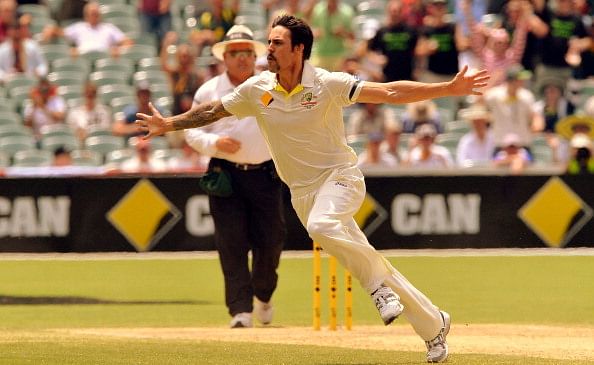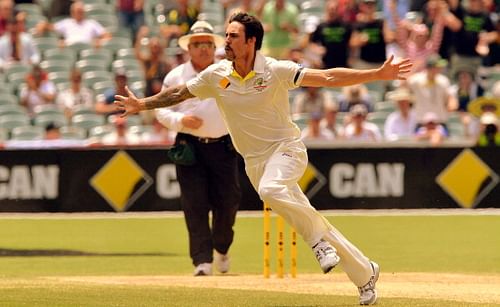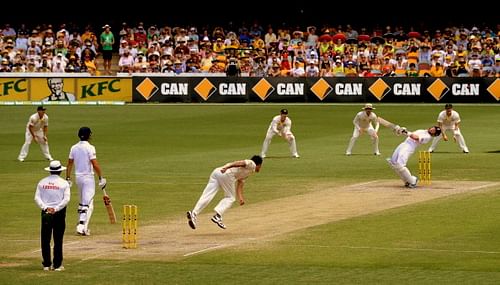
Mitchell Johnson - The 'tashed tormentor has brought the "show" back into fast bowling

Mitchell Johnson – the ‘tashed tormentor
2nd over, 4th delivery, 148.1 km/hr – the ball pitched, straightened a fraction, squared up Alastair Cook and then crashed into the off stump. Cook tried his best to go forward but was opened up like a can of beans.
They say morning shows the day and for England, the early signs weren’t too promising.
However, nothing much had happened since the 2nd over. Michael Carberry played a decent knock, Joe Root tried to replace Jonathon Trott at three and Kevin Pietersen disappointed, yet again. England were in a spot of bother, but the assuring presence of Ian Bell maintained a state of calm in the English dressing room.
Post lunch, 50th over, 1st ball, 144 km/hr – Ben Stokes, completely beaten by pace, played all around it and was wrapped on the pads. The entire Australian team appealed, but Marius Erasmus said “Not Out”. Michael Clarke called for the DRS and the replays showed that the ball would have disturbed the furniture.
Thus began the destruction.
The next two balls zoomed past Matt Prior, almost knocking his head off, and then the fifth made him poke at a wide one, caught his edge and Brad Haddin claimed the catch.
In came Stuart Broad – England’s Phantom warrior. He took guard, looked around, complained about the sight screen and then, after a series of shenanigans, decided to face up.
50th over, 6th ball, 148.4 km/hr – Broad shuffled on to his off stump, the thunderbolt zipped off the track and pegged back his leg stump. England’s “invisible” warrior stayed at the crease for 5 minutes but it was those 15 seconds that rocked the foundation of the English hopes in the Ashes.
It was carnage from there on.
Graeme Swann swung at a wide one after a couple of snorters, James Anderson had his middle stump cartwheeling off the ground and then Monty Panesar met the same fate after a dogged stay of 35 balls.
Mitch Johnson picked up 7 wickets in the innings – six of which came in a spell of 24 deliveries, conceding only 16 runs. However, it wasn’t the number of wickets that mattered; it was the devastation that the ‘tashed tormentor inflicted on the English army that will stay in memory for a long time to come. In a display of sheer pace, Mitch Johnson uprooted England’s hopes of repeating their home performances on Australian soil.
As Ian Chappell once said, “Genuine fast bowling can change a game or a series quicker than any other skill in cricket.”
Mitchell Johnson has done just that for Australia.
A couple of months ago Australia limped, coughed and scratched through an Ashes series in England. The team lacked skill, quality, penetration but importantly, motivation. The batting was frail and the bowling was friendly. A few things have changed since then, and perhaps the biggest was the inclusion of the raw pace of Mitchell Johnson.
Johnson has been one of those talented cricketers who take a while to come around. Blessed with immense talent, Johnson’s biggest challenge was to set his mind to the game and take his talent seriously. He was branded as one of Australia’s prime talents by none other than Dennis Lillee, but a series of injuries and a string of ordinary performances saw the feisty left-armer lose his spot to the Pattinsons.
Then came IPL-6 and Mumbai Indians came calling for a genuine fast bowler. Johnson got his ticket to the carnival and during the tournament was reborn as a fast bowler. Challenged with demanding franchise owners, flat decks, heavy bats and hard hitting batsmen, Johnson had no other option but to redefine himself. He stripped himself of the subtleties of the slower ones and the knuckle balls and decided to gain a few knots per hour.
And that was it, really. The speedometer jumped beyond 145 km/hr and the wickets started to pile up. Most importantly, the batsmen started to flinch. Suresh Raina and Yuvraj Singh felt the sting during the ODI series in India and now, the entire English batting order looks nervy.

Mitchell Johnson has brought back some serious pace in cricket
From being an out-of-favour bowler, Mitchell Johnson is now Australia’s prime weapon. He isn’t only taking wickets, he’s creating havoc and is planting doubts inside the heads of the English batsmen. Whenever he reaches on top of his mark and turns towards the batsmen, feet are starting to freeze, the reflexes slowing, techniques jamming and the brain is making bad decisions. England has had no answer to his pace and now even the better players in the side are starting to wilt.
That’s what a real fast bowler does. He not only picks up wickets, but creates an environment of fear and helplessness amongst the enemy ranks. Johnson’s success at Gabba was helped by a responsive pitch but his spell at Adelaide, on a track that saw Australia score 570, was a reminder of what serious pace can do to your opposition.
As for England, the batsmen are clearly haunted by the demon called “Mitchell Johnson”. He has dented their confidence and has got into their psyche. For them, every delivery is way too fast and seems unplayable. They are perpetually expecting a barrage of fast short deliveries and in the process losing their wickets to the ones pitched up. The spell at Adelaide was a clear indicator – none of the wickets fell to a short delivery; out of the seven wickets, four were castled, one was trapped in front and two were caught behind.
That’s where Johnson has improved as a bowler. He now knows how and when to use the short ball, and plans for a wicket. Although he still isn’t getting the ball to swing in the air, he is hitting the deck hard to extract the maximum possible juice and seaming it just enough. And when you can do that at extreme pace, the batsmen aren’t going to be a happy lot.
However, more than the bounce, movement and the technicalities, Mitch Johnson has got the swagger back into the Australian team. He’s brought back the glaring stares, the vociferous appeals, the “oohs and aahs” after a great delivery and the energy into the close-in fielders, who are diving for every catch and aren’t shying away from giving a piece of their mind to the batsmen.
Johnson has brought the “show” back into fast bowling. In an age where the batsmen rule the game, the spinners take the new ball and the pacers bowl slowers, Johnson has brought the machismo back into fast bowling. He has brought back the whispers in the opposition dressing room, the panic in the incoming batsmen, the beads of nervousness on their brows, the uneasiness in their eyes and the fear of ending up with a “broken f*****g arm”.
In the player creation mode of video games, there’s a category that says “late bloomers”. It took six years, 52 Tests, 214 wickets, a season in the IPL and a magic ‘tash for Mitchell Johnson to bloom.
But can he overcome his problems with consistency?
Maybe he can, maybe he can’t, but that’s a question for another day. As of now, he has stamped his name on the urn for this Ashes series and at 32, he has finally arrived at the party in full throttle.